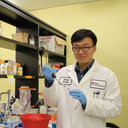Childhood and juvenile meningiomas.
Schlüsselwörter
Abstrakt
OBJECTIVE
The purpose of this paper was to study the clinical characteristic, treatment, and prognosis of childhood meningioma.
METHODS
Fifty-four meningioma cases below the age of 18 have been treated in Huashan Hospital in the last 15 years (from 1993 to 2008), their sex and age distribution, clinical manifestation, radiological finding, pathological subtype, treatment, and prognosis are retrospectively analyzed, and the results are compared with those reported in the literature.
RESULTS
The ratio of male to female was 1.16:1 (29:25) and mean age was 13.14 years (ranging from 2.75 to 18 years). Five patients in this series were associated with neurofibromatosis-2. The most common symptoms and signs were the signs of increased intracranial pressure including headache, papilledema, and vomiting. The most common radiological finding was homogeneous enhancement with contrast. The most common locations of meningiomas in this series were intraventricular and anterior/middle fossa. All of these patients were surgically treated; resection both in Simpson grades I and II could be achieved in 39 out of 54 patients. Perioperative mortality was 3.7% (2 out of 54); the most common postoperative complications were intracranial infection and injury of cranial nerve. Fibroblastic meningiomas were the most common pathological subtype, and malignant and atypical meningiomas (both of grades II and III according to WHO classification) accounted for 18.5% of the whole series.
CONCLUSIONS
Childhood meningiomas are scarce in clinical practice, which are characterized with its male predominance, large size, distinctive radiological features, and high rate of atypical/malignant histological subtypes; favorable outcome is accessible with total removal.




